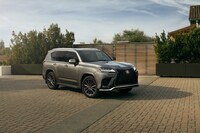Hybrid drivetrains — in luxury vehicles — are less about fuel efficiency than they are about more power and better performance. The new Lexus LX700h — the hybridized version of the LX ultra-luxury SUV — is a case in point.
The optional hybrid drivetrain doesn't appreciably increase the miles per gallon — but it very much increases the horsepower and torque.
What It Is
The LX is — basically — an ultra-luxury iteration of the Toyota Sequoia. Both are full-size/three-row SUVs built on the same underlying platform and share similar mechanicals, including their standard 3.4-liter twin-turbo V6 engines. One of the big differences is that the Sequoia comes standard with basically the same hybrid drivetrain that's optional with LX.
This is surprising, given that the Sequoia is much less expensive — $62,425 to start — than the non-hybrid LX600 Premium, which stickers for $107,450 to start.
The $114,500-to-start LX700h Overtrail comes equipped with the hybrid-augmented version of the 3.4-liter V6 that's standard in the Sequoia.
That's nearly twice as much as the base-trim (but hybrid-equipped) Sequoia costs. Being a Lexus rather than a Toyota, the LX700h's hybrid drivetrain does tout more power (457 versus 437 horsepower), and it does come standard with some other things, including a 25-speaker Mark Levinson ultra-premium audio system, massaging front seats, ventilated second-row seats, 22-inch wheels, ultra-premium leather seat covers and trim as well as a 2,400-watt inverter you can use to power high-draw accessories.
Every LX also comes standard with a beverage cooler built into the center console, an adaptive suspension and an electrically locking center differential. Also, all LXs come standard with four-wheel drive; it's optional with the base-trim Sequoia, which comes standard with rear-wheel drive.
The Overtrail also has 33-inch all-terrain tires on 18-inch wheels, front and rear locking differentials, skid plates, all-weather rubber floor mats and unique-to-this-trim exterior and interior styling differences.
If you prefer crisper on-road handling, there's the $117,000 700h F Sport, which has 22-inch wheel with low-aspect-ratio (short sidewall) tires for sharper steering feel, sport suspension tuning, sport buckets up front, along with aluminum-trimmed pedals and an "aero" body kit unique to this trim.
A top-of-the-line LX700h Ultra Luxury — $140,500 — nixes the third row in favor of a much more expansive and luxurious two-seater passenger area, with a pair of luxury captain's chairs for the backseat occupants that can be reclined and that come standard with massagers, along with a twin 11.4-inch display entertainment system and rear center table.
What's New for 2025
Both the optional hybrid-augmented drivetrain and the Overtrail trim are new for 2025.
What's Good
— Superlatively luxurious — even the "base" LX600.
— Available with luxuries that aren't offered with the Sequoia.
— Hybrid augmentation bumps up the power without cratering the miles per gallon.
What's Not So Good
— Hybrid augmented drivetrain that's an expensive extra in the Lexus comes standard in the Toyota.
— Standard (non-hybrid) drivetrain in the Lexus isn't as powerful as the hybrid-augmented drivetrain that's standard in the much less expensive Toyota.
— Toyota (and so, Lexus) have had some early teething troubles with the 3.4-liter V6 engine.
Under the Hood
The 600 versions of the LX come standard with a twin-turbo 3.4-liter V6 that touts 409 horsepower and 479 foot-pounds of torque. This relatively small (relative to the size and weight of this full-size SUV) makes more power than the much larger 5.7-liter V8 that was standard in the LX through the 2021 model year. The old V8 touted 383 horsepower and 403 foot-pounds of torque — as well as 12 mpg in city driving and 16 mpg on the highway. The current 3.4-liter V6 engine brings that up to 17 mpg city, 22 mpg highway. Adding hybrid augmentation is also a way to increase power even more — without incurring compliance costs.
In this case, adding a hybrid element — high-voltage battery pack and electric motor power supplementation — bumps the total drivetrain output to 457 horsepower and 583 foot-pounds of torque, without an appreciable decrease in fuel economy. In fact, the much stronger hybrid-augmented drivetrain in the "h" versions of the LX rates slightly better mileage: 19 mpg city, 22 mpg highway. Of course, no one's going to pay the roughly $7,000 it costs to upgrade from the base LX600 to the least expensive version of the "h" to gain 2 mpg. The sell is the 48 horsepower (and 104 foot-pounds of torque) upgrade you get.
You also get 8,000 pounds of towing capacity — a 1,000-pound increase from the last V8-powered version of the LX.
A 10-speed transmission is standard with both the hybrid-augmented V6 and the V6 by itself. Full-time 4WD (with a two-speed transfer case and 4WD Low gearing) are also standard with either setup.
On the Road
Everything about the LX is calming, including the silent-but-potent twin-turbo drivetrain. Especially when hybrid-augmented, because it is often literally silent yet extremely potent. Having nearly 600 foot-pounds of torque at your command is like having the most potent muscle car V8's power at your command — it'll get you to 60 mph in about 5.4 seconds if you need it to — but without the drama.
The quiet is very much like an electric car's — but without the worry, since you don't have to be anxious about the range or the wait, since it only takes a few minutes to fill up the LX700h's tank. However, it does run dry faster — than the LX600's tank — because it's got a smaller tank (18 versus 21 gallons). The three gallons less works out to about 50 miles less range, which means more frequent stopping for a top-off. The hybrid-augmented RX700h's tank is smaller because space had to be carved out for the hybrid equipment (the electric battery and high voltage battery).
Perhaps the most appealing thing about the LX is that — big as it is — it doesn't feel bigger than it is. Perhaps because it's not as wide as some of the other full-size SUVs currently on the market. A Cadillac Escalade is 81.2 inches wide. The LX is a comparatively svelte 78.3 inches, and if you don't think a couple or so inches makes much difference, try driving an Escalade or similar wider-through-the-hips SUVs on a narrow country road with little or no shoulder, and then try the LX.
At the Curb
The LX — 600 or 700 — doesn't look like it costs as much as it does, and that's good if you aren't interested in projecting to the world what you can afford to drive. It's handsome rather than ostentatious. Interestingly, it is also not as long as the Sequoia it shares its platform with. The Lexus is 200.5 inches long versus 208.1 inches long for the Toyota. A Cadillac Escalade is 211.9 inches long; a Benz GLS is 205 inches long. The Lexus is thus one of the smaller full-size luxury SUV.
This has its pros — and cons.
The pro is that the Lexus is easier to park — especially curbside — and it takes up less space in the garage. The con is that the Lexus has less-than-average cargo room versus most of the others in the class. It has only 11 cubic feet of space behind its third row and maxes out at 64 cubic feet with its second and third rows folded. Its several-inches-longer Toyota cousin has twice the cargo space (22.3 cubic feet) behind its third row and maxes out at 86.9 cubic feet. The Escalade eclipses them both, with 25.2 cubic feet behind its second row and a max of 121 cubic feet, the most in the class by far.
The third row is also tight given the size of the LX. Not just because the LX is not quite as long other full-size luxury SUV like the Cadillac Escalade and Benz GLS. It has a solid rear axle (i.e., it does not have an independent rear suspension), and that pushes the floorpans up in the area where the third row is, with the result that passengers back there sit with their legs kind of bunched up.
On the other hand, the Lexus is available in a unique-in-the-class four-seater configuration. The Ultra Luxury ditches the third row and the second row's middle seat. The space that's opened up allows for the reclining rear seats, which can be used as beds on long trips. These also come with a five-option massage function, which your passengers can enjoy while they watch a movie on the rear-seat entertainment system that's also bundled with the Ultra Luxury standards.
The Rest
Hybrid-augmented models have a watertight battery case, a sensible precaution for a vehicle with off-road equipment that might be used to ford creeks and such. Overtrail models come with an underbody camera system that's useful for seeing rocks and such that might dent the floorboards or hang up the LX when you're driving offroad.
The Bottom Line
That old saying about there being no replacement for displacement turns out to no longer be true.
On the other hand, speed is still a question of money. How fast do you want to go?
Eric's latest book, "Doomed: Good Cars Gone Wrong!" will be available soon. To find out more about Eric and read his past columns, please visit the Creators Syndicate webpage at www.creators.com.
View the Lexus LX700h this week.







View Comments